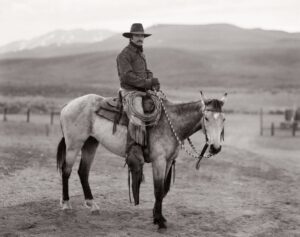Jay Dusard: Direct Gaze

September 2010 – December 2010
Martin Black, Stampede Ranch, Nevada. Digital print from an 8×10-inch negative, ed. 50, 1982. Copyright Jay Dusard
Direct Gaze combines Dusard’s photography that spans more than two decades, from 1980 – 2002, providing a glimpse of the ever diminishing yet profoundly cherished American West.
Inspired by his personal connection to the people and cowboy culture of the west, Dusard captures panoramic landscapes and cowboy portraits with an authenticity only a trusted fellow cowpuncher could achieve. Among Dusard’s influences are his mentor, artist/photographer Frederick Sommer, and photographers Ansel Adams and Arnold Newman. Like Sommer, Dusard used an 8 x 10 view camera for most of the work produced on the during his travel to some 45 ranches from British Columbia to Chihuahua.
Dusard’s style is honest, open and uncomplicated in his portraits of the people living and working as modern day cowboys and they return this with their own candor and direct gaze at the camera’s lens, the photographer, and the eye of the viewer.
Born in 1937 in St. Louis, Missouri, Dusard has been the subject of museum exhibitions including: Charles M. Russell Museum, the Phoenix Art Museum, Glenbow Museum, Colorado Springs Fine Arts Center; Art Museum of South Texas, and the International Photography Hall of Fame. Dusdard’s 1981 Guggenheim Fellowship launched his grandest adventure. With camera, bedroll, and saddle, he motored wide-ranging “circles” throughout the domain of working cowboys, vaqueros, and buckaroos. He “rode for the brand” with many of them and returned with timeless images. This “adventure” resulted in the publication, The North American Cowboy: A Portrait (1983), followed by Open Country, a book which earned third place in the 1994 Photographic Book of the Year competition.